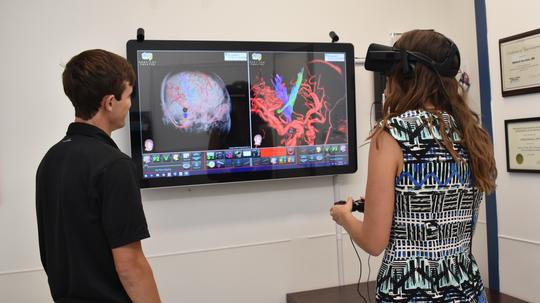
Dr. Abilash Haridas has practiced brain surgery in a number of ways: he's analyzed CT scans and even literally drawing out a brain on a sheet of paper to review the different avenues he could take during the procedure.
While he still does this, Haridas has a new way to practice that is ultimately changing the game for doctors and patients alike — and it involves virtual reality.
St. Joseph's Children's Hospital in Tampa, a subset of BayCare Health System in Clearwater, is the first pediatric hospital in the southeastern United States to offer a virtual reality service that takes MRIs and CT scans to create a 3D model that is easily navigable with the ease of virtual reality glasses. While 2D and even 3D models have been used at St. Joseph's, the newest virtual reality option allows physicians to delve even deeper.
"Now I have another tool — you don't forget your other ones, but it's like reading a map," Haridas said. "Now there's a more advanced way to do it."
It is made possible by Ohio-based Surgical Theater Precision Virtual Reality, which reached out to Haridas to implement the program in St. Joseph's. No financial details were disclosed.
"Instead of showing a patient where everything is backwards (since MRIs are flipped) and black and white, this shows a 3D model to highlight different areas where you can fly in," Michael Miller, VR program lead for Surgical Theater, said.
The model can be used to benefit both the doctors performing the surgeries and patients and families who are trying to wrap their heads around the process. Physicians, nurses and medical students will be able to better view the brain, the problem area and "fly through" different avenues they can take to perform the brain surgery.
"This is one facet of the future," Haridas said. "There are so many changing things in medicine and this is an incredible addition and revolutionizes the way that not only doctors, but patients experience what's going on in their heads."
And while it is new technology for some, for the families in the pediatric wing, it is something many of them are already familiar with.
"We've noticed especially in the pediatric population, that kids who are 5 years and above are naturally drawn to this," Haridas said. "It's very easy to understand; children are children and millennials have been brought up in this culture, so for them this is the only way to understand or grapple with understanding. And this has really helped me avoid using a lot of technical language, which adds more clarity as oppose to confusing them. Because when you're under stress, it can cause a lot of distraught and that's where technology helps."









